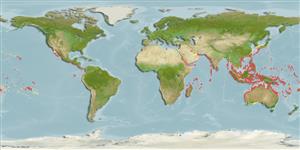Common names from other countries
Environment: milieu / climate zone / depth range / distribution range
Ökologie
seewasser; brackwasser riff-verbunden; tiefenbereich 0 - 20 m (Ref. 48637). Tropical
Indo-Pacific: East Africa to Samoa and the Hawaiian Islands.
Size / Gewicht / Alter
Maturity: Lm ? range ? - ? cm
Max length : 7.5 cm TL Männchen/unbestimmt; (Ref. 11344)
Rückenflossenstacheln (insgesamt) : 7; Rückenflossenweichstrahlen (insgesamt) : 9; Afterflossenstacheln: 1; Afterflossenweichstrahlen: 8. Brown with irregular spots; dorsal and caudal fins with bands in females, dusky in males; often with dark brown saddle below each of the dorsal fins (Ref. 2798); characterized further by having upper five pectoral rays with free tips and sixth ray partly free; three branches on upper four pectoral rays; rounded caudal fin; longitudinal scale series 37-38; predorsal scales 18-20, reaching or nearly reaching interorbital space; cheek and opercle without scales; presence of fleshy double flap from edge of cheek into notch at posterior end of upper lip; ctenoid body scales, becoming cycloid on abdomen, breast, base of pectoral fin and nape; depressed head, width greater than depth; depth of body 4.3-5.5 in SL (Ref. 90102).
Inhabits intertidal seaward reef flats (Ref. 37816, 48637). Also found in shallow reefs near shore (Ref. 90102).
Life cycle and mating behavior
Maturities | Fortpflanzung | Spawnings | Egg(s) | Fecundities | Larven
Benthic spawner.
Randall, J.E. and M. Goren, 1993. A review of the gobioid fishes of the Maldives. Ichthyol. Bull. J.L.B. Smith Inst. Ichthyol. (58):1-37, 5 pls. (Ref. 9360)
IUCN Rote Liste Status (Ref. 130435)
CITES (Ref. 128078)
Not Evaluated
Bedrohung für Menschen
Harmless
Nutzung durch Menschen
Tools
Zusatzinformationen
Download XML
Internet Quellen
Estimates based on models
Preferred temperature (Ref.
115969): 24.2 - 29.3, mean 28.2 (based on 3609 cells).
Phylogenetic diversity index (Ref.
82804): PD
50 = 0.5000 [Uniqueness, from 0.5 = low to 2.0 = high].
Bayesian length-weight: a=0.01023 (0.00477 - 0.02194), b=3.02 (2.84 - 3.20), in cm Total Length, based on LWR estimates for this (Sub)family-body shape (Ref.
93245).
Trophic level (Ref.
69278): 3.4 ±0.5 se; based on size and trophs of closest relatives
Widerstandsfähigkeit (Ref.
120179): hoch, Verdopplung der Population dauert weniger als 15 Monate. (Preliminary K or Fecundity.).
Fishing Vulnerability (Ref.
59153): Low vulnerability (10 of 100).
